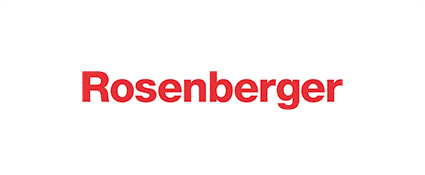
Founded over 60 years ago in Fridolfing, Bavaria, the Rosenberger Group is now a leading international manufacturer of connectors and cable assemblies. The corporation offers a wide portfolio of standardized and custom connection solutions in high-frequency, fiber optic, and high-voltage technology to renowned high-tech companies in mobile and telecommunications, automotive, medical, and industrial electronics, industrial measurement and testing technology, as well as aerospace. The company employs over 15,000 people worldwide, 3,300 of them at the headquarters.
The main plant of Rosenberger has always been in Fridolfing, from where production for the entire world is managed. The necessary production apparatus is spread across several facilities in ten halls. To maintain an overview of the machinery in the buildings, Rosenberger used large-format LED display boards for decades, which showed the status of each machine in the respective hall. Employees could see the machine status, but the display was rigid and the only summary available. Thus, only limited information could be read, solely from the machine software. Additionally, any change or adjustment to the production lines required an external technician to manually reprogram or rebuild the display. Another pain point was the availability of spare parts—due to the age of the boards, these were hardly available. Consequently, Rosenberger decided to look for a new, flexible solution that could process data from multiple sources to display more important information for the staff alongside machine data on several screens.
The requirements for the new solution were clearly defined at the beginning of the search: “We wanted a solution that quickly and easily displays production data and the status of our machines on various screens simultaneously and can be used easily in all areas. Additionally, it should be possible to display more information than just the machine status,” summarizes Stefan Speigl, IT Application Manager at Rosenberger. The final solution was found through a long-term partner. The initial contact with Peakboard GmbH came through the in-house MES provider. The Stuttgart-based company combines process data from all common data sources in real-time with its Low-Code platform, networking the entire production. This system enables the user to easily create applications such as data visualizations, digital shopfloor management, or individual MES functionalities, or to function as an HMI (Human Machine Interface). Peakboard was chosen not only for the recommendation but also for the seamless integration of its solution into existing systems. The solution runs at the edge of the existing network and can be set up independently without extensive IT knowledge.
The Peakboard solution used at Rosenberger consists of a hardware component, the Peakboard Box, and a software component, the Peakboard Designer. With the help of the Peakboard Designer, Rosenberger creates individual dashboards for each hall from the data provided by the MS-SQL database of the MES system (by MPDV). These are displayed on multiple large screens per hall, replacing the old LED display boards. Setting up the individual displays takes only a few hours. At the beginning of the project, Rosenberger technicians created a basic template, which was adapted to each hall. This template shows the respective hall layout with the available machines. These are represented by individual circles, whose color indicates the current status of the machine. Additionally, numbers from 1 to 3 in the circles show the priority of the machine in the current production cycle (PRIO status). Furthermore, the Peakboard Boxes access the system 10-15 times less frequently, minimizing query load.
Thanks to the regularly updated dashboards, staff can get an optimal overview of the current production status at any time and from any point in the hall without having to walk along the entire production line. Whenever a circle turns red (signal color for a malfunction), an employee can respond immediately to prevent possible long-term outages.
Initially, the project was implemented in two production halls—now, the solution is used in over seven buildings. Depending on the size and workload of each hall, Rosenberger uses different numbers of screens. Currently, there are over 40 devices in use, with the trend rising. Equipped with a Peakboard Box, they are either suspended as cube constructions from the ceiling or mounted on the walls.
Peakboard is now used in almost all production halls at the Fridolfing site. Due to the user-friendly application and integration, Rosenberger no longer needs technical support from external technicians. A single employee manages the various Peakboard dashboards in all halls and can easily adjust them as needed. For Stefan Speigl, the solution from the Stuttgart-based company significantly eases the workload. “Previously, it was not only impossible to capture the status of all machines at a glance, but it was also cumbersome to make adjustments to the displays. Today, information from several systems can be linked and displayed on a single dashboard. This can be adjusted independently and easily, significantly increasing flexibility,” Speigl summarizes. The collaboration with Peakboard will be further expanded, with the equipment of additional halls and possible applications in logistics and IT planned.